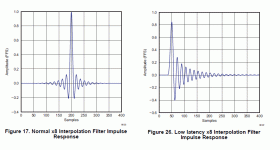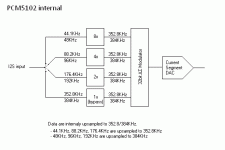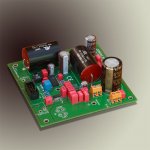TI announce the PCM5102 a DAC chip integrating two different digital filters, a direct path 2V RMS ground centered output.
PCM5102 Audio Stereo DAC (29 Apr 2011)
Datasheet: PCM5102
Few characteristics:
- Hardware control,
- Full scale output 2.1V RMS (Ground center),
- No DC blocking capacitor required,
- Sampling frequency 8KHz to 384kHz,
- Accepts 16, 24 and 32 bit audio data,
- Classical FIR Brickwall filter and Apodising IIR filter
- Integrated high-performance audio PLL to generate SCK internally
This chip seems ideal for simple DAC.
PCM5102 Audio Stereo DAC (29 Apr 2011)
Datasheet: PCM5102
Few characteristics:
- Hardware control,
- Full scale output 2.1V RMS (Ground center),
- No DC blocking capacitor required,
- Sampling frequency 8KHz to 384kHz,
- Accepts 16, 24 and 32 bit audio data,
- Classical FIR Brickwall filter and Apodising IIR filter
- Integrated high-performance audio PLL to generate SCK internally
This chip seems ideal for simple DAC.
You're the first to post :
http://www.diyaudio.com/forums/digital-line-level/192608-pcm-5102-dac.html
Patrick
http://www.diyaudio.com/forums/digital-line-level/192608-pcm-5102-dac.html
Patrick
hi EUVL,
No the second one 😉You're the first to post: http://www.diyaudio.com/forums/digital-line-level/192608-pcm-5102-dac.html
Patrick
Hello guys ,i just received from TI 5 PCM5102...
Hi Patrick,
I have some doubts that many people were interested by a thread named 'PCM5102'. Except if they already knew this circuit.
ionutzxpo want help for its personal realization. It is not really an open thread to speak about PCM5102's interesting characteristics.I meant you were NOT the first.
Why not merge the two threads ?
Patrick
I have some doubts that many people were interested by a thread named 'PCM5102'. Except if they already knew this circuit.
Hi guys,I am a beginner in digital audio conversion and i don't know how to connect the PCM2707 to PCM 5102 to make a simple functional USB DAC with much much better performance than any other integrated sound solution (I use computer for music playback)
i got my sample up and running last night. It's sort of similar (but better i think) to the wolfson WM8524 used in the GrubDAC.
It is a very easy DAC to implement and interface to. It needs very few components to make it work, and only needs a single 3.3V supply. I've only listened to it briefly so far. I'm thinking only a tiny PCB would be needed to piggyback onto my MiniDSP to replace the built-in DACs.
It is a very easy DAC to implement and interface to. It needs very few components to make it work, and only needs a single 3.3V supply. I've only listened to it briefly so far. I'm thinking only a tiny PCB would be needed to piggyback onto my MiniDSP to replace the built-in DACs.
from reading the PCM5102 evaluation board datasheet, it seems that there may be a PCM5122 chip as well in the future, which has software control and digital volume control.
Can I use a microprocessador to have a usb assync 24/192khz like this http://www.diyaudio.com/forums/digital-source/185761-open-source-usb-interface-audio-widget.html ?
regards
joao
regards
joao
There is one significant difference with this DAC that deserves some consideration as compared to the 9022/23 - the master clock implementation.
The 9022/23 requires an external low noise master clock whether working synchronously or asynchronously.
From the datasheet the 150x chips can generate the master clock from the incoming data stream using a internal PLL and no external master clock input or oscillator. In doing so it supports any sample rate frequency directly with only the bit clock, L/R, and data signals. A good question is how well it does this? It would be very interesting to see how good this internal PLL and oscillator are by building one and doing some testing.
If this PLL mode works well this may be an interesting way to shave off the expense of the external oscillator and its low noise power supply (as compared to the 9022/23 at least).
If it does not work as well in PLL mode as the 9022/23, an external oscillator can be supplied to the 1502 but it must be selected to work on either 44.1KHz multiples or 48KHz multiples. It won't do both with one clock frequency.
The best performance looks to be achieved with an external low noise oscillator and working synchronously from an SD player or a fixed rate transport, etc. This is probably where the comparison between the 9022/23 and the 1502 should be made because it is the closest thing to an apples-to-apples comparison.
Food for thought...
I am looking forward to someone trying it out.
Dave
The 9022/23 requires an external low noise master clock whether working synchronously or asynchronously.
From the datasheet the 150x chips can generate the master clock from the incoming data stream using a internal PLL and no external master clock input or oscillator. In doing so it supports any sample rate frequency directly with only the bit clock, L/R, and data signals. A good question is how well it does this? It would be very interesting to see how good this internal PLL and oscillator are by building one and doing some testing.
If this PLL mode works well this may be an interesting way to shave off the expense of the external oscillator and its low noise power supply (as compared to the 9022/23 at least).
If it does not work as well in PLL mode as the 9022/23, an external oscillator can be supplied to the 1502 but it must be selected to work on either 44.1KHz multiples or 48KHz multiples. It won't do both with one clock frequency.
The best performance looks to be achieved with an external low noise oscillator and working synchronously from an SD player or a fixed rate transport, etc. This is probably where the comparison between the 9022/23 and the 1502 should be made because it is the closest thing to an apples-to-apples comparison.
Food for thought...
I am looking forward to someone trying it out.
Dave
Can I use a microprocessador to have a usb assync 24/192khz like this http://www.diyaudio.com/forums/digital-source/185761-open-source-usb-interface-audio-widget.html ?
regards
joao
Joao,
It looks like it would probably work. Keep in mind that the 9022/23 and the 1502 pin out differently and require different bypass and control pin considerations so you cannot just solder it in place of the 9022/23.
Dave
(edited to remove incorrect mode statement)
Last edited:
I think similar technique was used by YM 3623B receiver; I liked that chip a lot. Yamaha chip was locking on an external clock and then disconnecting that input while using an internal PLL controlled oscillator to provide clock signals internally. This was also an attempt to isolate cheap quartz xtal oscillator from receiver internal processing. It seemed that it worked quite well - this receiver was regarded as one of the better sounding chips... Anyhow, I installed LC clock XO2 inside DPA DAC (that uses Yamaha receiver chip) not knowing the above… and noticed huge improvement in sound definition, extension… exactly the same as whit all other chips…. So I don’t know what to think about chips with an internal PLL that does not require external clock signal to be present all the time…. the DPA DAC LC clock XO2 had its own dedicated low noise power supply (and separate transformer).
Boky
Boky
Dave,
We have done a PCB for the 5102 to tests, but have not yet found time.
It has, however, MLCC caps that you hate. 🙂
If you don't mind, you are welcome to a test board.
Though I know from experience you rather do your own.
Rest see email.
Cheers,
Patrick
We have done a PCB for the 5102 to tests, but have not yet found time.
It has, however, MLCC caps that you hate. 🙂
If you don't mind, you are welcome to a test board.
Though I know from experience you rather do your own.
Rest see email.
Cheers,
Patrick
Hi Patrick,
Ceramics still have thier place for me and I have used many over the years. I took an untraveled path with film caps and liked where it took me, that's all. I need to build one of my 9023 boards with all ceramics to listen to. It may be better...
I'll send you an email about testing a board. I look forward to doing it.
Dave
It has, however, MLCC caps that you hate. 🙂
Ceramics still have thier place for me and I have used many over the years. I took an untraveled path with film caps and liked where it took me, that's all. I need to build one of my 9023 boards with all ceramics to listen to. It may be better...
I'll send you an email about testing a board. I look forward to doing it.
Dave
Hi Patrick,



Does the quality is proportional to the size 😉
If the PCM5102 doesn't work correctly with this environment, it probably never works correctly


Eric
Your PCB is about 4x the size as the one I am using.
😉
Patrick



Does the quality is proportional to the size 😉
If the PCM5102 doesn't work correctly with this environment, it probably never works correctly



Eric
- Status
- Not open for further replies.
- Home
- Source & Line
- Digital Line Level
- PCM5102, 2VRMS ground centered direct output with two digital filters


